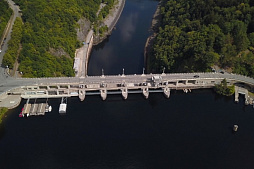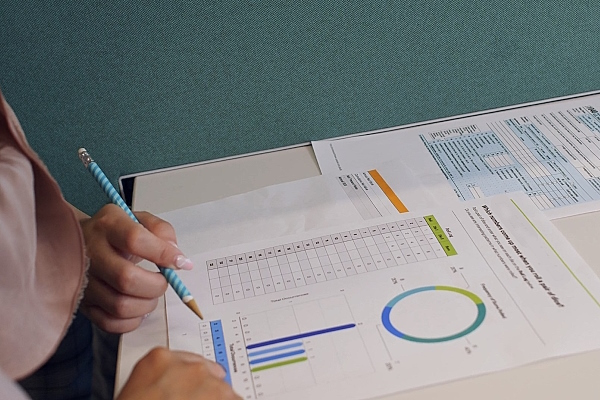After receiving the necessary documents and project presentation, our team will try to review your request as soon as possible, and leading experts will offer the best options for project funding.
In this guide, we navigate the terrain of financing, unraveling the complexities that accompany project funding.
From risk management strategies to stakeholder engagement, we talk about the crucial components that support successful financial initiatives.
Setting the stage for financing of investment projects
In large business at an international scale, the ability to secure strategic financing of investment projects is a critical determinant of success. From understanding the investment landscape to risk analysis, the following steps lay the groundwork for effective project financing.Understanding the current investment situation
Modern large investment projects come in various forms, ranging from startups and expansions to innovative ventures and large-scale developments.Total investments in infrastructure, construction sector and engineering today amount to several trillion dollars a year and change under the pressure of a number of external factors, highlighting the vast opportunities and challenges that large businesses face regularly when seeking financial support.
In this environment, the need for strategic planning and preparation cannot be overstated. Before diving into the financing journey, it's crucial to gain a comprehensive understanding of the project's scope and objectives. This involves defining the target market, assessing the competitive international landscape, and identifying key performance indicators.
Crafting a detailed business plan
At the heart of strategic financing lies a well-crafted business plan. Practice shows that the absence of a thoroughly developed business plan makes long-term external financing of projects practically impossible. The business plan should encapsulate not only the essence of the project but also serve as a roadmap for financial success.Within the business plan, the executive summary provides a short overview, capturing the project's vision, mission, and unique value proposition. Market analysis delves into industry trends, target demographics, and competitive positioning. Moreover, a comprehensive financial projection offers a glimpse into the project's anticipated revenue, expenditures, and profitability over time.
Assessing capital requirements
Understanding the financial needs of the project is paramount.According to comparisons of various projects and industries, the difference in investment cost per unit of capacity in similar projects can be hundreds of percent. Identifying the capital requirements for particular project involves an examination of costs associated with production, marketing, technology, and any unforeseen contingencies.
In this pursuit, professional financial modeling becomes a cornerstone activity. This includes leveraging tools and methodologies to create accurate revenue projections, cost estimates, and cash flow analyses is imperative. A well-structured financial model not only guides decision-making but also instills confidence in potential investors and lenders.
Risk and return analysis
No discussion about strategic financing is complete without acknowledging the inherent risks associated with investment projects. Understanding and mitigating risks early in the financing process is essential for long-term viability.During the study of your project, the GCAM Investment Group team will offer specific strategies for risk management, exploring how to identify potential pitfalls and develop effective mitigation plans. Additionally, we will navigate the financing options, ensuring you are well-equipped to make informed decisions tailored to your unique needs.
Investment project preparation and planning
Preparation and planning of large investment projects serve as the bedrock upon which successful enterprises are built.This initial phase is akin to crafting a roadmap, guiding stakeholders through the intricacies of project development. From defining the project's scope and goals to conducting exhaustive market research and culminating in the creation of a detailed business plan, this comprehensive process requires a strategic and informed approach.
Step 1: Defining project scope and objectives
Before considering the intricate details of project financing, it is very important to establish a clear and concise project scope and objectives. This foundational step sets the groundwork for the entire investment endeavor.This includes the following key aspects:
• Clarity in scope: Clearly define the boundaries of the project. What are the specific deliverables, target outcomes, and any limitations or constraints?
• SMART objectives: Ensure that project objectives are Specific, Measurable, Achievable, Relevant, and Time-bound. This framework enhances goal-setting precision.
• Stakeholder alignment: Engage with stakeholders to ensure alignment on project scope and objectives. A collaborative approach fosters a shared understanding and commitment.
Step 2: Conducting market research
Market research serves as the compass guiding investment project toward success. A comprehensive understanding of the market is crucial for informed decision-making.Key considerations include:
• Industry analysis: Examine the broader industry trends, growth projections, and potential disruptors. Identify the competitive landscape and assess market saturation.
• Target audience: Define your target audience with precision. Understand their needs, preferences, and pain points. This is important for product / service customization.
• SWOT analysis: Conduct a SWOT analysis (Strengths, Weaknesses, Opportunities, Threats) to identify internal and external factors influencing project success. Mitigate weaknesses and capitalize on strengths.
Step 3: Creating a detailed business plan
A robust business plan is the cornerstone of successful project financing. It not only communicates business vision but also demonstrates a thorough understanding of the project's financial landscape.Table: The business plan should be divided into several components.
| Components | Description | Key points |
| Executive summary | The executive summary always encapsulates the essence of the particular project and its infrastructure. | Project vision and mission |
| Unique value proposition | ||
| Market opportunities | ||
| Financing requirements | ||
| Financial projections | Accurate financial projections instill confidence in potential investors. | Revenue projections: Based on realistic market assessments. |
| Cost estimates: Breakdown of anticipated expenditures. | ||
| Cash flow analysis: Detailed insight into the project's liquidity. | ||
| Capital requirements | Identifying and articulating capital needs is pivotal. | Detailed cost breakdown: Outlines how funds will be allocated. |
| Funding timeline: Clearly depicts when capital injections are required. | ||
| Contingency planning: Accounts for unforeseen circumstances with a contingency fund. |
In essence, this phase of investment project preparation lays the groundwork for a comprehensive understanding of the project's context, market positioning, and financial requirements.
Each element is interconnected, contributing to a holistic approach that strengthens subsequent activities.
Financial modeling
In the investment project management, financial modeling emerges as a potent force, illuminating the path to fiscal prudence and effective strategic decision-making.This is a dynamic process that encapsulates revenue projections, cost estimations, and cash flow analyses. Furthermore, sensitivity analysis takes center stage, allowing stakeholders of the project to navigate the impact of key assumptions on its financial health and prospectives.
Step 1: Developing a comprehensive financial model
Reliable financial model is the compass that navigates any large project through the complexities of revenue generation, cost management, and overall financial viability. GCAM Investment Group experts prioritize financial modeling, providing their clients with customized models taking into account long-term goals and the needs of a specific project and core business.Table: Essential components of a comprehensive financial model.
| Components | Brief description | Key points |
| Revenue projections | Precise revenue projections are the lifeblood of any financial model. | Sales forecast: Projections based on market demand, pricing strategies, and sales channels. |
| Market trends: Analysing industry trends and customer behavior to anticipate revenue fluctuations. | ||
| Product / service life cycle: studying the life cycle of your offering and its impact on revenue streams. | ||
| Conducting cost estimates | Accurate cost estimation is integral to maintaining financial health. | Fixed and variable costs: Differentiating between costs that remain constant and those fluctuating with production or sales. |
| Direct and indirect costs: Identifying costs directly tied to the project versus those indirectly influencing overall expenses. | ||
| Contingency planning: Including a buffer for unforeseen costs to enhance financial resilience. | ||
| Cash flow analysis | Cash flow analysis provides insights into the movement of funds within the investment project. | Operating activities: Tracking cash inflows and outflows related to day-to-day operations. |
| Investing activities: Assessing cash transactions related to investments in assets or divestments. | ||
| Financing activities: Analysing cash movements resulting from debt, equity, or dividend transactions. |
Step 2: Conducting sensitivity analysis
Sensitivity analysis fortifies the financial model by stress-testing assumptions and gauging the project's resilience to external factors.It serves as a dynamic lens, allowing businesses to scrutinize the impact of varying key assumptions on their financial outlook. Instead of relying on fixed predictions, this approach acknowledges the dynamic nature of business environments.

Practical recommendations for conducting sensitivity analysis:
• Understanding key assumptions: Begin by identifying the pivotal assumptions embedded in your financial model. These might include user acquisition costs, subscription renewal rates, or development expenses. Recognizing these critical factors is foundational to the sensitivity analysis process.
• Stress testing assumptions: Take each significant assumption and subject it to stress testing. This involves systematically altering the assumption within a reasonable range to observe its repercussions on financial metrics. For instance, explore the impact of a 10% increase in user acquisition costs.
• Impact on revenue projections: Evaluate how changes in assumptions reverberate through revenue projections. Consider scenarios where assumptions lead to higher or lower revenues than anticipated. This provides insights into the model's flexibility.
• Cost implications: Understand the cost implications of altered assumptions. If there's an unexpected spike in development costs, analyze how this affects operational expenses and overall cash flow. This helps in preparing for unforeseen financial challenges.
• Considering external variables: Look beyond internal assumptions and consider external variables. Changes in market trends, consumer behavior, or regulations can significantly impact your business. Incorporate these considerations into your analysis.
• Scenario analysis: Go far beyond isolated assumptions and conduct analysis. Explore a spectrum of possible future scenarios. For instance, consider what happens to cash flow if user growth exceeds expectations or falls below projections.
• Developing risk mitigation strategies: Based on sensitivity analysis insights, develop strategies to mitigate identified risks. This could involve setting aside contingency funds, negotiating favorable contracts, or diversifying revenue streams.
• Continuous monitoring and adaptation: Sensitivity analysis is not a one-time effort. Regularly update your analysis as your business evolves. Incorporate new data and insights to ensure your model remains adaptive and reflective of changing circumstances.
• Informed decision-making: Leverage sensitivity analysis insights for strategic decision-making. If a particular assumption proves highly sensitive, use this information to guide proactive decision-making and risk management strategies.
• Effective communication: Effectively communicate the results of sensitivity analysis to stakeholders. Transparently share insights about potential risks and mitigation strategies. This fosters a shared understanding and confidence among stakeholders.
By weaving these components into the financial model, project team not only creates a dynamic tool for decision-making but also demonstrate a proactive approach to potential challenges. This financial foresight positions the project for adaptability and success in the face changes.
Identifying potential financing sources
In the pursuit of securing essential funds for any serious investment project, a strategic approach to identifying potential financing sources is critically important.This section navigates through diverse ways, each offering unique opportunities for injecting capital into new project.
Equity financing
Equity financing involves raising capital by selling ownership stakes in a business.Investors, such as angel investors, venture capitalists, or private equity firms, provide funds in exchange for equity or ownership shares. This method allows businesses to acquire capital without incurring debt, and investors typically share in the company's success through potential profits and capital appreciation. While equity financing dilutes existing ownership, it often brings strategic guidance and industry expertise from investors, fostering long-term partnerships for business growth.
1. Approaching angel investors
Angel investors, often seasoned entrepreneurs or high-net-worth individuals, play a pivotal role in fueling early-stage projects. Beyond providing capital, they often bring valuable industry insights and mentorship. Its important to research potential angel investors aligned with the project's domain, and craft a compelling pitch that highlights the value proposition and growth potential.2. Exploring venture capital opportunities
Venture capital presents a robust avenue for new businesses poised for rapid expansion. The so-called VC firms deploy capital in exchange for equity, aligning their success with the project's growth. Financial team must thoroughly research venture capital firms, identifying those with a track record in particular industry.3. Considering private equity partnerships
Private equity partnerships are particularly pertinent for established businesses seeking substantial capital injections. Private equity firms usually acquire a stake in your company, often with a focus on strategic growth and operational improvements. Its also important to identify private equity partners with a portfolio aligned to particular industry and articulate how their involvement can catalyze project's success.Debt financing
Debt financing is a method of raising capital by borrowing funds that must be repaid with interest over time.It involves securing loans from traditional banks, government-backed programs like SBA loans in the USA, or issuing bonds and debentures to investors. Unlike equity financing, debt financing does not dilute ownership but entails a legal obligation to repay the borrowed amount.
While it provides immediate access to funds, businesses utilizing debt financing must carefully manage repayment schedules and interest obligations to maintain financial stability. Striking the right balance between equity and debt financing aligns with your project's objectives and sets the stage for sustainable growth.
1. Evaluating traditional bank loan options
Traditional bank loans remain a cornerstone of debt financing, offering stability and structured repayment plans. This requires approaching local and national banks, assessing loan terms, interest rates, and collateral requirements. A solid credit history, a comprehensive business plan, and collateral assets enhance project eligibility for securing a bank loan.2. Assessing bond and debenture options
For projects requiring substantial capital and possessing a stable revenue stream, bonds and debentures emerge as viable debt financing instruments. Bonds represent a form of debt security with fixed interest payments, while debentures are unsecured debt instruments. Financial team should assess the feasibility of issuing bonds or debentures, considering interest rates, market conditions, and the creditworthiness of particular project.Alternative financing
Alternative financing encompasses non-traditional methods for securing capital outside of traditional banking or equity channels.This may include crowdfunding platforms like Kickstarter, where large investment projects raise capital from a number of contributors, peer-to-peer lending where individuals lend directly to borrowers through online platforms, and seeking grants or subsidies from governmental or private entities.
Alternative financing is characterized by its diversity, often offering creative and community-driven solutions for funding projects with unique social, technical, or artistic value.
This type of financing diversifies capital sources and often brings community support and visibility to the project.
Government grants and subsidies present non-traditional avenues for securing financing, especially for projects with social or technological impact. In these cases financial team should research grant programs offered by governmental bodies, non-profits, or industry-specific organizations, ensuring alignment between project objectives and the eligibility criteria outlined by these programs.
Building partnerships for financing investment projects
Organizing project financing, especially at the international scale necessitates adept relationship-building and strategic partnerships.In essence, building relationships and partnerships in the context of large investment projects is about fostering connections that transcend the transactional. It involves creating a network of advocates, collaborators, and supporters who not only contribute financially but also share in the vision and contribute to the overall success of the project.
1. Identifying key stakeholders
The entity should proactively engage with financial institutions, such as banks, investment funds, and other relevant entities that specialize in project financing. Collaborative efforts can be directed towards exploring various financing options, optimal loan structures, and risk-sharing mechanisms that contribute to the successful implementation of the investment project.2. Exploring public-private partnerships
Consideration should be given to the exploration of public-private partnerships (PPPs), particularly for large-scale projects. By forming multifaceted collaborations with government entities, the entity can access additional resources, regulatory support, and smooth infrastructure development, enhancing the overall feasibility of the project.3. Active expansion of the partner network
Participation in major industry events, conferences, and networking opportunities is recommended for companies looking for a partner for a capital-intensive project. These platforms offer the chance to connect with potential investors, financiers, and partners. The entity should be prepared to present the investment project convincingly, emphasizing its value proposition.4. Introduction of financial innovations
Leveraging innovative technology platforms, such as crowdfunding platforms, investment forums, and digital marketplaces, is another avenue to explore. These platforms can broaden the reach and attract diverse sources of financing for the investment project.5. Emphasizing diplomatic efforts
Engagement in diplomatic efforts and government relations is essential, particularly for international projects. Building relationships with relevant government officials and agencies in the countries where the project will take place can facilitate regulatory approvals and create a favorable environment for financing at the initial stage and subsequent support.6. Developing risk mitigation strategies
Risk mitigation strategies, including insurance and guarantees, should be considered. Partnerships with insurance providers or entities offering financial guarantees can enhance the attractiveness and security of the investment project for potential investors.7. Doing responsible business
The firm should emphasize the social responsibility aspects of the investment project, showcasing its contributions to local community development, environmental sustainability, and social welfare. This approach attracts investors and financiers with a focus on socially conscious investments.The development of a comprehensive partnership strategy is crucial. Regardless of whether we are talking about financing the construction of a power plant, laying a railway or developing a tourism project. This strategy should clearly outline the objectives, roles, and responsibilities of participants, emphasizing the alignment with the goals of the project and the mutual benefits for involved parties.
Risk management in financing investment projects
In organizing the financing of investment projects, prudent risk management is the cornerstone of success.The firms spearheading such endeavors must develop a comprehensive strategy to identify, assess, and mitigate risks effectively. Our team will help you understand the intricacies of formulating a robust risk management strategy for financing large investment projects.
Generally, each type of risk management strategy focuses on specific aspects of risk mitigation and contributes to an overarching risk management framework. Find out more below.
Table: Key risk management strategies applicable to the financing of investment projects.
| Strategies | Description | Application |
| Risk avoidance | This strategy involves steering clear of activities or aspects of the project that pose significant risks. It might include avoiding certain markets, technologies, or partnerships that are deemed too risky for the project's objectives. | Entities might choose to avoid entering markets with high political instability or opt against utilizing cutting-edge but unproven technologies. |
| Risk transfer | Risk transfer involves shifting the responsibility for identified risks to another party. This is often done through contractual agreements, such as insurance policies or outsourcing certain project components to specialized firms. | Purchasing insurance coverage for potential project risks or outsourcing specific tasks to external vendors with expertise in risk-prone areas. |
| Risk reduction (mitigation) | This strategy aims to lessen the impact or likelihood of identified risks. It involves implementing proactive measures to reduce the severity of potential negative events. | Conducting regular equipment maintenance to prevent breakdowns, implementing safety protocols to reduce accidents, or diversifying supply chain sources to mitigate the impact of disruptions. |
| Risk acceptance | In some cases, entities may choose to accept certain risks because the cost of mitigating or avoiding them outweighs the potential impact. This strategy involves acknowledging the existence of risks and preparing to manage the consequences. | Accepting the possibility of minor delays in project timelines due to weather conditions that cannot be entirely controlled. |
| Contingency planning | Contingency planning involves preparing specific responses for identified risks, allowing for swift and effective action when risks materialize. | Developing detailed contingency plans for potential budget overruns, supply chain disruptions, or regulatory changes. |
| Diversification | Risk diversification involves spreading project activities, resources, or investments across different areas to reduce the impact of a failure in any single component. | Investing in multiple geographic locations, industries, or revenue streams to reduce the overall risk exposure. |
| Focus on research | This strategy focuses on thorough research and investigation before making key decisions. It helps identify and assess potential risks associated with partners, suppliers, or project locations. | Conducting extensive due diligence on potential contractors, suppliers, and partners to ensure reliability and adherence to regulations. |
| Hedging strategy | Hedging involves using financial instruments to offset the impact of adverse price movements or fluctuations in currencies, commodities, or interest rates. | Utilizing financial derivatives such as futures contracts to hedge against currency exchange rate fluctuations. |
| Monitoring and early warning systems | Implementing systems for continuous monitoring of key performance indicators and early detection of deviations from the plan. This allows for intervention in the face of emerging risks. | Employing data analytics and technology solutions to monitor project metrics and detect potential issues before they escalate. |
| Strategic partnerships | Forming strategic partnerships with entities that bring complementary strengths, expertise, or resources to the project, thereby sharing and mitigating risks collaboratively. | Partnering with a local firm for market insights and regulatory expertise when entering a new international market. |

By combining and tailoring these risk management strategies, entities can create a comprehensive and adaptive framework that addresses unique challenges associated with financing large projects.
Reducing risks step by step
A well-crafted risk management strategy is indispensable for financing large investment projects.By addressing potential risks comprehensively, utilizing suitable risk management tools, and maintaining adaptability, individuals and firms can navigate the complex landscape of large-scale projects with confidence and increase the chance of achieving their objectives.
The following typical steps will help arrange project financing smoothly and securely.
1. Risk identification and assessment
The initial phase of any effective risk management strategy involves an examination of potential risks.The entities must conduct a thorough risk assessment, considering both internal and external factors that could impact the project. This encompasses financial, operational, regulatory, environmental, and geopolitical risks.
2. Scenario analysis and modeling
Utilizing right scenario analysis and modeling enables stakeholders to simulate various potential outcomes based on different sets of circumstances. By considering a range of scenarios, individuals or entities can better understand the potential impact of identified risks and tailor their risk mitigation strategies accordingly.3. Financial risk management
Financial risks, including global market fluctuations, interest rate changes, and currency volatility, are inherent in large investment projects. Implementing financial risk management tools such as hedging, derivatives, and insurance can help mitigate the impact of adverse financial events and ensure stability in the project's cash flow.4. Contractual safeguards
The formulation of airtight contracts is pivotal in risk management. Contracts should explicitly define responsibilities, timelines, and deliverables, as well as include clauses that allocate risks appropriately among project stakeholders. A well-structured contract serves as a reliable legal safeguard, providing recourse in the event of unforeseen circumstances.5. Contingency planning
No matter how exhaustive the risk assessment process, unforeseen things can still happen. Establishing a robust contingency plan is vital to promptly address and mitigate risks as they unfold. Contingency plans should outline step-by-step responses to various risk scenarios, ensuring a swift and coordinated reaction from project stakeholders.6. Regulatory compliance and due diligence
Staying abreast of regulatory requirements and conducting thorough due diligence are critical components of modern risk management. Compliance with local and international regulations minimizes legal risks, while due diligence ensures that potential risks associated with partners, suppliers, and project locations are thoroughly vetted.7. Stakeholder communication and engagement
Effective communication with all stakeholders is important in managing risks. Establishing transparent channels of communication fosters a collaborative environment where potential risks can be openly discussed, and mitigation strategies can be collectively formulated. Regular updates and engagement with stakeholders ensure alignment with project goals and risk tolerance levels.8. Insurance strategies
Employing insurance as a risk mitigation tool provides an additional layer of protection. Insurance options may include project-specific policies covering construction, liability, and business process interruption, among others. Careful consideration of insurance needs and obtaining comprehensive coverage can shield the project from unforeseen financial setbacks.9. Technology and data analytics
Leveraging innovative technology and data analytics enhances risk management capabilities. Advanced analytics can identify patterns, predict potential risks, and provide real-time insights, enabling proactive decision-making. Embracing these solutions facilitates the monitoring of key performance indicators (KPIs), ensuring early detection of deviations from the project plan.10. Continuous monitoring and adaptation
A dynamic risk management strategy is not a one-time effort; it requires continuous monitoring and adaptation. Regular reviews of the risk profiles, reassessment of risk appetite, and adjustments to risk mitigation strategies based on project progress are essential to keep the strategy relevant and effective throughout the project lifecycle.GCAM Investment Group offers a wide range of financing opportunities for investment projects in Europe and beyond.
If you need professional services in the field of financial engineering (for example, financial modeling), you can also contact our team for advice.




























